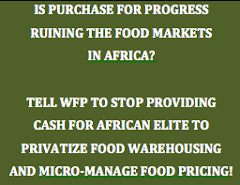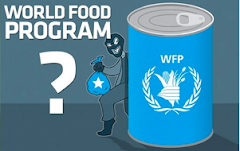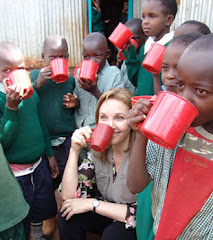http://allafrica.com/
Paul Busharizi
14 October 2009
interview
Kampala — IN the run up to the World Food Day tomorrow, October 16, Paul Busharizi, spoke to the the World Food Programme (WFP) country director, Stanlake Samkange, about Purchase for Progress, a new WFP initiative poised to make Ugandan small-holder farmers major players in the regional quality grain market.
Outline what the Purchase for Progress programme is all about. When was it initiated and what prompted its creation?
The Purchase for Progress, or P4P, is a five-year pilot project that WFP launched last year in partnership with the Bill and Melinda Gates Foundation.
It aims at working with governments in 21 developing countries, including Uganda, to expand market opportunities for small-holder farmer groups.
In recent years, WFP has realised that increased cash contributions from donors have made it possible for it to become a stable and substantial purchaser of food in developing countries.
About two years ago, WFP started to explore ways in which these purchases could promote development of small-scale agriculture. That was the origin of P4P.
The project in Uganda features two main aspects; developing market infrastructure, both physical and informational, and enhancing productivity. Plans have been developed in collaboration with the Ministry of Agriculture, Animal Industry and Fisheries.
Regarding enhanced productivity, WFP will complement the work of the Food and Agriculture Organization (FAO) by assuring demand, supporting improved post-harvest handling and encouraging value addition.
What does WFP hope to achieve with this initiative?
WFP foresees P4P as a major catalyst of increased agricultural production, which will result in the gainful participation of small-holder farmers in the market. The initiative should open up the regional quality food market for Uganda's small-holder farmers.
Under the project and other purchase mechanisms, WFP would like to double the amount of food it has been buying in Uganda in recent years to make about $100m worth of purchases annually, in the next five years. This should help farmers improve their quality of life through increased incomes.
P4P is one of WFP's longer-term solutions to global hunger. In Uganda, it has been positioned to support the Poverty Eradication Action Plan, the Plan for Modernisation of Agriculture and the anticipated National Development Plan.
What is the progress so far in rolling out this project in Uganda?
P4P was launched globally about a year ago. Through the warehouse receipt system, we have bought close to 1,000 tonnes of maize from farmer groups in the Jinja and Masindi. We would like to buy about 3,000 by the end of the year.
In collaboration with SG 2000 and the Uganda Commodity Exchange (UCE), we have sensitised over 3,400 farmer group leaders in post-harvest handling and agricultural financing.
In the next few weeks, we will begin to construct a 2,000-tonne regional warehouse, which will be equipped with a cleaning and drying plant. We recently opened an office in Iganga and will soon open one in Hoima. The new offices will help us take demand closer to producers.
Busoga produces substantial amounts of maize, but it is of poor quality, largely due to the use of poor post-harvest methods. Now we can work closely with the farmer groups to help them improve their quality.
Mostly, we have been buying maize and beans through competitive bidding. However, last December, WFP signed an agreement with the commodity exchange and began direct purchases through the warehouse receipt system. In the next few weeks, we would like to start making forward contracts with farmers.
We want to buy maize and beans, as well as other staples including, sorghum, millet and fish. With alternative staples, we can buy more food and offer a bigger market.â-àWe will at the same time be able to address micro-nutrient deficiencies in crisis areas such as Karamoja
What is Uganda's potential as a regional or international supplier for the WFP?
There are times when WFP has been forced to buy food from South Africa, ship it to Mombasa, transport it across Uganda to the DR Congo. That is because there is not enough quality grain or beans in the region.
With improved supply, quality and market guarantees from WFP and other P4P innovations, Uganda can produce enough maize for the region. WFP can absorb everything that Uganda can produce, but we cannot buy it all because then it would upset the market. Under P4P, WFP is looking to work with the FAO and the national agricultural advisory services to increase production. FAO supports farmer field schools, where farmers come together to learn about productive agriculture.
WFP will assist farmer field schools, mostly in northern Uganda, by supporting market linkages and providing a market.
Are you exporting any of the food?
About 20% of the food that WFP buys in Uganda is exported to Rwanda, Burundi and DRC. The remaining 80% is used to support operations in Uganda.
In the coming months, however, we expect a reduction in relief needs in Uganda and see WFP take a lead in supporting regional operations through local purchases in Uganda.
What have been the major challenges in rolling out the project in Uganda? Sensitisation, poor agricultural practices, or the economic environment?
The main problems that farmer groups face are the lack of cleaning and drying equipment and adequate modern storage facilities. Farmers are often forced to dry their maize on the ground at the mercy of unreliable weather, which compromises quality. And then, they are forced to rely on stores that can only take about five tonnes.
Some farmers that have signed contracts to supply food to WFP are sometimes forced to sell their food since they are unable to meet the quality and quantity specifications required by WFP. WFP has made orders for cleaning and drying equipment. We will supply it in areas where we have collaborations with UCE and where we will set up market collection points. Kapchorwa, Kasese, Masindi, Gulu and Iganga districts will be some of the first beneficiaries.
What are the possibilities for value addition under this programme and what form could this (value addition) take?
P4P will support grain milling for easier cooking, fortification with micro-nutrients, bagging to prevent tampering, and drying, salting and smoking of fish to increase its shelf-life. Also, P4P intends to support processing, working with farmer associations and the private sector.
How does P4P relate to this year's theme for the World Food Day: "Achieving food security in times of crisis"?
Recently, the media has been reporting on the impacts of the global economic crisis. We need to realise that not everybody, who has been affected, works for a big bank, a big insurer or a major car company.
The FAO has said the global crisis is stalking small-scale farmers of the world, in part because of dwindling amounts of money sent home from relatives working abroad and last year's high fuel and food prices. P4P should help make small-scale farmer groups beneficiaries, not victims of the crisis.
The approach that WFP uses in strengthening regional trade for Uganda, is not to establish itself as the sole buyer, but rather as one of the buyers.











